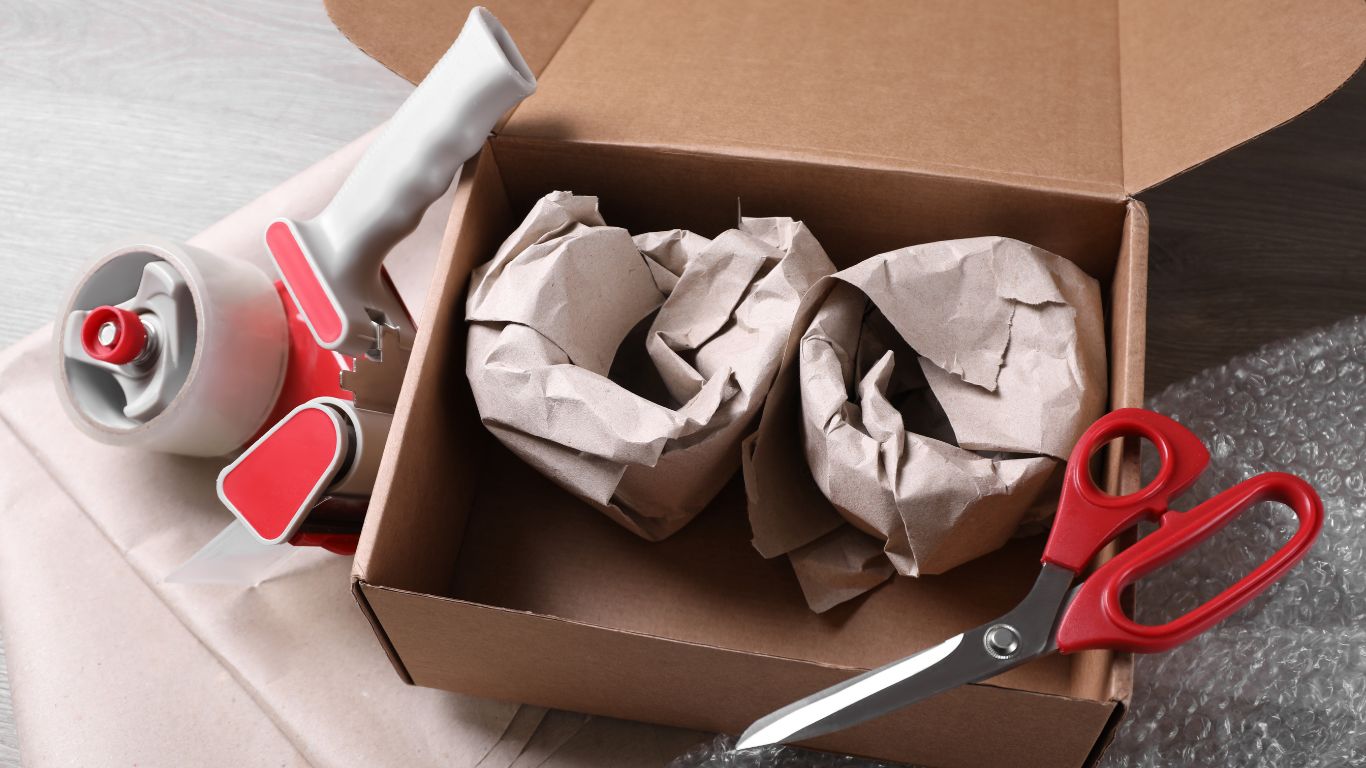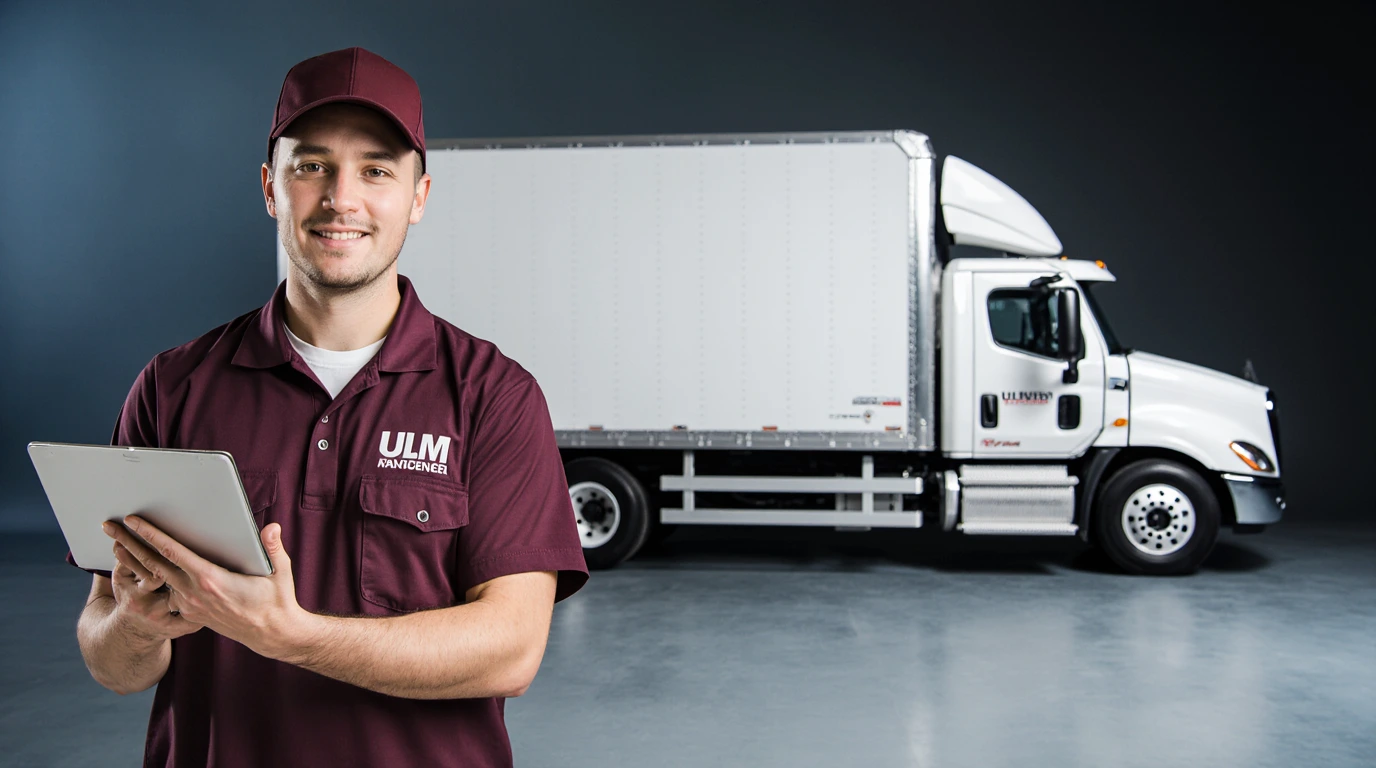In this article, we will provide you with expert tips and tricks to help you pack like a pro. From gathering the necessary supplies to decluttering your home, from packing delicate items to loading a moving truck, we’ve got you covered. So, if you want to make your next move a smooth and successful one, keep reading for valuable advice and insights.
-
- Professional Packaging vs. DIY
- Packaging Techniques for Specific Household Items
- Loading a Moving Truck
- Unloading and Unpacking
Moving can be a stressful and overwhelming process, but with the right packing techniques, it can become a breeze. Whether you are moving across town or across the country, proper packaging is essential to ensure the safety and security of your belongings.
General Packaging Tips:
Prior to embarking on the packing process in preparation of your cross country movers arriving, it is crucial to allocate some time for decluttering, crafting a comprehensive moving checklist, and assembling all the necessary supplies.
Gathering Packing Supplies
- Opt for high-quality boxes of different sizes to cater to the diverse range of items you need to pack. For delicate items such as dishes, wardrobe pieces, or artwork, it’s worth considering investing in specialty boxes.
- Make use of a variety of packing materials like bubble wrap, packing peanuts, packing paper, cozy blankets, and foam sheets to provide utmost protection for your precious belongings.
- Ensure you have durable packing tape, markers, labels, furniture covers, cleaning supplies, and scissors on hand to effectively seal and identify your items.

Decluttering Your Home Before Packing
- Instead of overwhelming yourself with the daunting task of decluttering your entire house all at once, it’s beneficial to take a more focused approach. Break the task down into smaller, manageable steps. For example, you can start by decluttering one room at a time or set a goal to declutter a certain number of items each day or week. This approach allows you to stay organized and motivated throughout the process, making it easier to achieve your decluttering goals.
- Organize your belongings into separate piles, categorizing them as items to keep, donate, sell, or discard. This process of decluttering not only reduces the number of items you need to pack but also helps minimize your moving costs.
- Create a detailed inventory of your packed items by making a spreadsheet or list to help you stay organized during the move. This will allow you to easily track your belongings and ensure that nothing gets lost or forgotten.
- Take a moment to envision your new space. Picture the layout and storage options in your new home. Will there be enough room to accommodate all of your belongings? If not, it might be the perfect opportunity to part ways with some items. Letting go of a few things can open up space for new possibilities and help create a fresh start in your new home.
Pack Room by Room
- Begin by tackling rooms that are not used as frequently before moving on to the more frequently used ones.
- Organize similar belongings into cohesive groups to optimize the packing and unpacking process.
Use Proper Packing Techniques
- Carefully wrap each delicate item with bubble wrap or foam sheets, ensuring a snug fit to prevent any movement during the move.
- To safeguard your delicate dishes and glassware from any potential damage, it is highly recommended to utilize specialized dish packs and dividers. These purpose-built containers and separators offer extra protection and ensure that your fragile items remain intact throughout the moving process.
- To ensure maximum protection and minimize movement during transit, don’t forget to utilize crumpled paper or packing peanuts to fill any empty spaces in your boxes. This added cushioning will keep your belongings secure and intact throughout the moving process.
- Ensure that your boxes are tightly sealed using strong packing tape, with special attention given to the bottoms and edges.
Label Boxes Clearly
- Implement a comprehensive labeling system that clearly indicates the contents of each box and the specific room it belongs to.
- Implement a system of color-coding or numbering your boxes to make it effortless to identify them, particularly if you have an abundance of items to transport.

Pack Moving Essentials Separately
- Prepare a dedicated box filled with essential items such as toiletries, a fresh set of clothes, basic tools, crucial documents, chargers, and snacks. This box will ensure that you have immediate access to the necessities upon reaching your new destination.
Professional Packaging vs. DIY:
Expert Packaging Services
- Advantages of professional packing services are the expertise in handling your belongings, the time-saving aspect, and the assurance of proper packing techniques.
- It is recommended to obtain quotes from multiple moving companies and read reviews to ensure reliability and high-quality service.
DIY Packing for Move
-
- By packing for a long distance move yourself, you can save money while also having the freedom to organize your belongings to your liking.
- Dedicate some time to gather the necessary packing supplies and educate yourself on effective packing techniques.
Packaging Techniques for Specific Household Items
1. How to Move a Piano
Consultation and Preparation:
Seek guidance from reputable piano movers or experienced interstate moving companies who specialize in handling pianos. You can simply type piano movers near me into your search engine.
Prior to the move, it is important to ensure that the piano is in optimal condition by tuning it and addressing any necessary repairs.
Packaging and Loading:
Wrap the piano in moving blankets or specialized covers to protect it from scratches and damage during transit.
Use a dolly or piano skid to transport it to the moving truck. Secure it properly to prevent movement during transportation.
How Much Does it Cost to Move a Piano?

2. How to Move a Washer and Dryer
Preparation Steps:
Gather supplies such as moving blankets, sturdy packing tape, reliable appliance dollies or straps, essential tools like wrenches or pliers, and protective materials like bubble wrap or padding. These supplies will ensure that your belongings are properly secured and protected during the moving process.
Make sure to disconnect the utilities. Turn off the water supply and carefully detach the hoses from the washer, making sure to drain any remaining water. Similarly, disconnect the dryer from the power source and detach the vent hose. This step is crucial to ensure a smooth and hassle-free move for your appliances.
Clean and Secure:
Make sure to thoroughly clean your appliances, ensuring that there are no remnants of water in the washer or lint in the dryer. Additionally, double-check that all movable components, cords, or attachments are securely fastened to prevent any potential damage during transportation.
Moving a Washer:
Secure the Drum:
To ensure the safety of your washer during transport, make sure to secure the drum inside the machine with the help of drum lock or shipping bolts. For front-loading washers, use packing tape or a rope to firmly close the door and prevent any accidental openings while on the move.
Protecting a Washer During Move:
Safeguard the washer’s exterior from any potential scratches by enveloping it in either moving blankets or bubble wrap. This protective layer will ensure that your washer remains in pristine condition throughout the moving process.
Loading a Washer Into a Moving Truck:
Safely transport your washer onto a moving truck using an appliance dolly or sturdy moving straps. Keep the washer upright and avoid excessive tilting to protect its internal components from any potential damage.
Moving a Dryer:
Prepare the Dryer for Movers:
Before moving your dryer, make sure to remove any detachable parts such as shelves, racks, or knobs. Keep these parts organized in a labeled box for easy reattachment later. To prevent the dryer door from swinging open during transit, securely fasten it with packing tape or a bungee cord. This will ensure that your dryer remains safe and intact throughout the moving process.
Wrap and Protect:
Protect the surface of the dryer by securely wrapping it with moving blankets or bubble wrap.
Loading Dryer Into Truck:
Transport the dryer onto the moving truck using an appliance dolly or secure moving straps. Ensure that the dryer is positioned upright and avoid excessive tilting to protect the internal mechanisms from any potential damage.
Follow Manufacturer’s Guidelines:
If you have access to the appliance manuals, it is highly recommended to consult them for detailed moving instructions provided by the manufacturer. These instructions will provide you with valuable guidance on how to safely transport your appliances during the move.
3. How to Package a TV Stand
A TV stand is designed to be a compact and functional piece of furniture, making it difficult to disassemble into smaller parts. While you can remove the doors and shelves, there is limited room for further deconstruction.
Disassemble the Stand:
Position the TV stand onto a soft moving blanket, gently removing any attached doors and shelves. With the aid of a screwdriver, carefully unscrew each screw in a top-to-bottom fashion, disassembling the stand with precision.
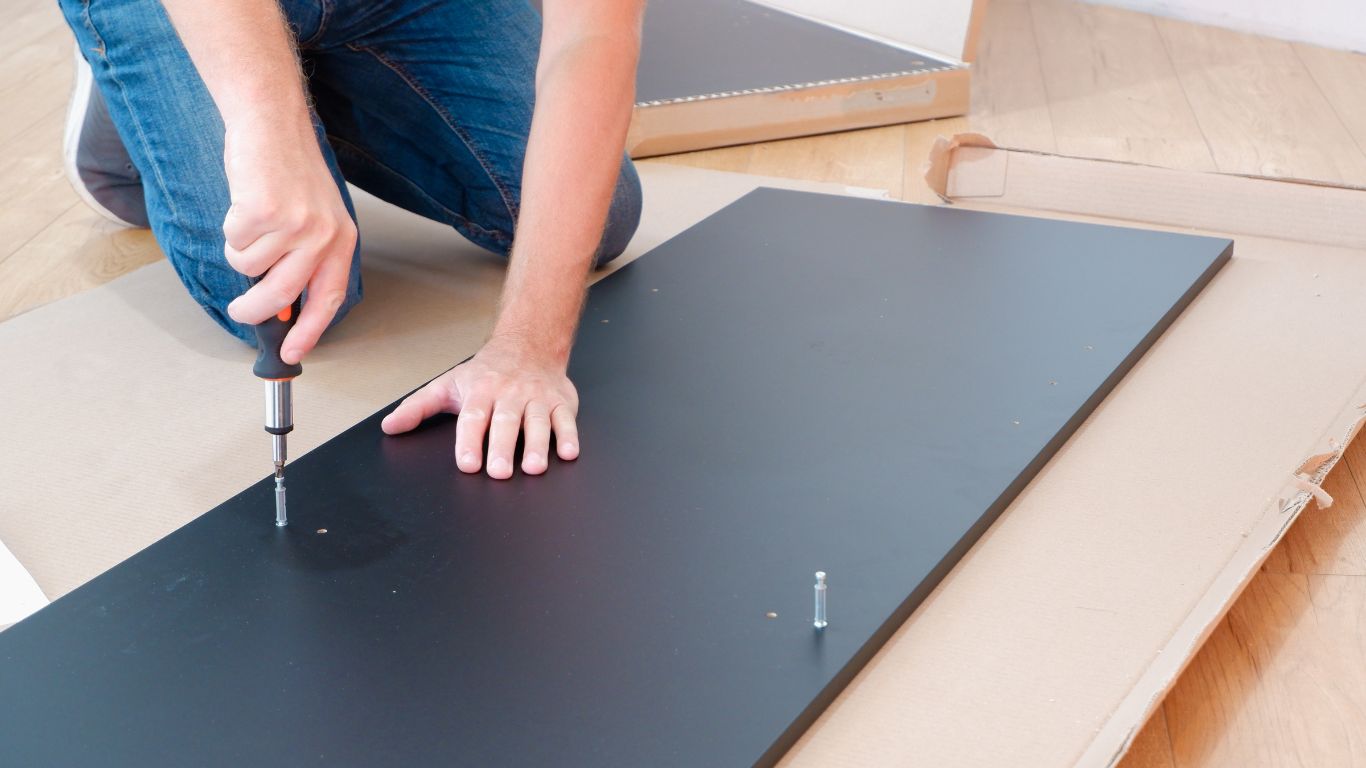
Wrap the Pieces:
Securely store the brackets and connecting pieces by placing them in a convenient plastic bag, and then attach them to the respective doors and shelves they belong to. Next, provide ample protection for the doors, shelves, and other components by wrapping them with multiple layers of packing paper, followed by a layer of bubble wrap.
Packing a TV Stand:
If you find yourself unable to disassemble the TV stand into smaller pieces, don’t worry! You can still pack it as it is. Simply wrap a moving blanket around the stand, ensuring a snug fit. Use packing tape to secure the blanket, making sure it only touches the blanket and not the surface of the furniture. Lastly, for added protection, wrap the legs of the stand in bubble wrap or shrink wrap to prevent any potential damage. Now your TV stand is ready for a safe and smooth move!
How to Move a TV Stand or Entertainment Center:
To ensure a smooth and hassle-free move for your entertainment unit, it’s important to make it easy to lift. If you have packed it in smaller pieces, it becomes much easier to lift and load onto the moving truck. However, if you prefer to move the unit without disassembling it, enlisting the help of a friend and using a furniture dolly or sliders can make the process much smoother.
For heavy furniture items like an entertainment center or TV stand, it is highly recommended to hire professional help. They have the expertise to wrap and load the unit for you, ensuring that it is handled with care and no damage occurs during the move.
4. How to Package a Fridge or Freezer
Measure Your Appliances, Doorways, and Stairwells:
Before transporting a refrigerator or freezer from your home to the moving truck, it is crucial to take measurements of your appliance, doorways, and stairwells. This will ensure that you can smoothly maneuver the fridge on a dolly and fit it through any tight spaces. It is highly recommended to prioritize this step to avoid the frustration of discovering that the appliance doesn’t fit at the last minute. Grab your trusty tape measure and determine the width, height, and depth of your fridge.
Once you have measured your appliance, it’s time to carefully plan the path you will take from your kitchen to the front door. Don’t forget to measure the doorways along the route as well. In some cases, you may need to remove doors to create more space for the fridge. Taking these measurements and planning your route in advance will save you time and ensure a smooth moving experience.
Empty Contents of Freezer or Fridge
Now comes the daunting step of clearing out the contents of your refrigerator and freezer. Take the time to discard any items that you won’t be consuming before the move. If you have unopened or untouched food, consider donating it to minimize waste. While it’s difficult to part with food, especially on a long-distance move, sometimes it’s just not feasible to bring it along. However, if you’re only moving your fridge a short distance, you can preserve any remaining food by storing it in an ice cooler. Just ensure that you have enough ice to maintain a safe temperature and keep your food fresh during the transition.
Defrost Your Fridge At least 24 Hours Before Move
Once you have emptied out your fridge, it’s time to tackle the defrosting process. Start by disconnecting the appliance and placing towels on the floor to catch any water that may drip from the melting ice. While you wait for the freezer to defrost, take the opportunity to clean the interior of your fridge, eliminating any potential for bacteria growth. A highly effective and safe cleaning solution is a quart of hot water mixed with two tablespoons of baking soda.
After your freezer has completely defrosted, it’s important to thoroughly clean and dry all surfaces of your refrigerator and freezer, both inside and out. Once this is done, leave the doors open for a minimum of 24 hours to allow any remaining moisture to evaporate. Even the slightest presence of moisture can lead to the growth of mold and mildew, so it’s crucial to ensure complete dryness. And don’t forget to empty, clean, and dry the evaporator pan as well for a truly comprehensive cleaning process.
Securing Appliances for Moving
Once you have thoroughly wiped away any remaining water inside the fridge, carefully remove the glass drawers, shelves, and any loose parts. This will help when moving heavy items. Make sure to clean and dry them before wrapping and packing them separately for the move. It’s important to prevent any shifting or breakage during transportation, so securely wrap them with blankets, towels, or bubble wrap. Afterwards, securely close the fridge door with a rope or moving strap to prevent it from opening while on the dolly. For an added layer of protection, wrap the entire fridge with a blanket or padded cover. This will ensure that your fridge stays safe and secure throughout the moving process.
Protecting Wood Floors During Move
To avoid damaging your floors, it’s important to take precautions when moving heavy refrigerators that are often wedged in tight spaces. Before loading the fridge onto a moving dolly, use furniture sliders or rubber mats to help slide it out smoothly. Tilt the refrigerator slightly backward and place protectors underneath – one on each side. Then, gently push it from side to side, gradually pulling the fridge forward. This will help protect your floors from scratches and ensure a seamless moving experience.
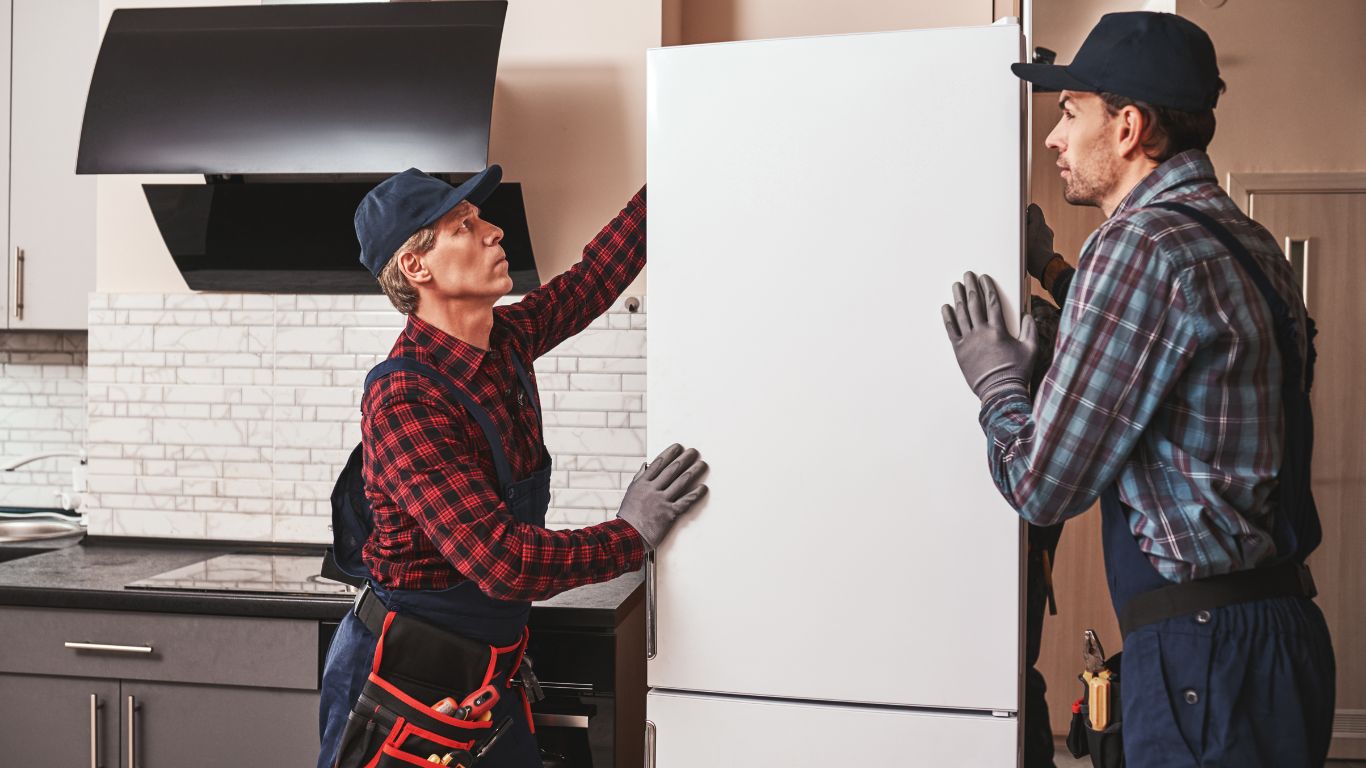
Transporting Fridge Into Moving Truck
Now that you have successfully maneuvered the refrigerator onto the dolly and securely fastened it with moving straps, you are prepared to glide it along your carefully planned route and onto the moving truck. Enlist the assistance of your helpers, positioning them on either side of the fridge to ensure its stability throughout the process.
With caution, navigate through doorways and descend stairs if necessary. Fortunately, most moving trucks are equipped with a ramp, allowing you to effortlessly roll the dolly onto the vehicle. Once inside the truck, shield the refrigerator from any potential harm by draping it with blankets and carefully placing it in a secure spot where it will remain upright. For added support, consider positioning other objects, boxes, or furniture adjacent to it.
5. How to Package Electronics for Move
Determining how to package your electronics depends solely on the item you are shipping. Some delicate electronic items may be able to withstand the move without additional padding, while others require extra protection. Properly packaging your electronics is crucial in ensuring their safe transportation.

For fragile electronic items, the original packaging provided by the manufacturer is the ideal choice. If you no longer have the original boxes due to various reasons, such as being used by children, your cat, or ending up in the recycling bin, you can reach out to the manufacturer and inquire if they can send you new ones.
If contacting the manufacturer doesn’t yield any results, don’t worry! I’ve got you covered with a comprehensive guide on how to safely package and ship your electronics.
- Start by detaching all additional components of the equipment, including cords, chargers, adapters, and any other accessories, and carefully wrap and pack each item separately.
- Wrap your electronic items in bubble wrap before placing them in the box. If your item has a screen, make sure to protect it by wrapping it in both bubble wrap and a soft towel. To safeguard against any potential water damage, place everything in waterproof bags or use plastic sheeting.
- Wrap towels or bubble wrap around the top and bottom edges of the box, creating a protective barrier. Then, carefully pack all of the items inside, making sure they are tightly secured to prevent any movement during the shipping process.
- Secure your electronics shipping box with sturdy tape, ensuring a tight seal. Give it a gentle shake to confirm that everything inside is secure, guaranteeing optimal protection for your valuable electronics during transportation.
6. How to Package Clothes and Linens
Tackling the organization and packing of your clothes and linens can feel like a daunting task, but fear not! Here are some tips to make the process more manageable and stress-free.
- Use vacuum-sealed bags: Vacuum-sealed bags are a game-changer when it comes to maximizing space and keeping your items safe during transportation. These bags are especially useful for larger and bulkier items like cozy comforters and winter coats. Not only do they protect your belongings from dust and moisture, but they also make packing and unpacking a breeze. With vacuum-sealed bags, you can say goodbye to clutter and hello to efficient and organized moving!
- Group items by category: Organize your clothes and linens by category and pack them separately for a more organized and hassle-free unpacking experience. This strategy will help you stay on top of things and maintain order throughout your move.
- Use hangers and wardrobe boxes: Optimize the packing process for your hanging clothes by utilizing wardrobe boxes. These specialized boxes allow your clothes to remain on their hangers, ensuring that they stay wrinkle-free and making it effortless to hang them up in your new home. Say goodbye to creased clothing and hello to a seamless transition!
- Label boxes clearly: Print the label for each box with a clear description of its contents and the name of the owner, like “Sarah’s fabulous dresses.” This simple step will streamline the unpacking process and make it a breeze to locate exactly what you need in no time.
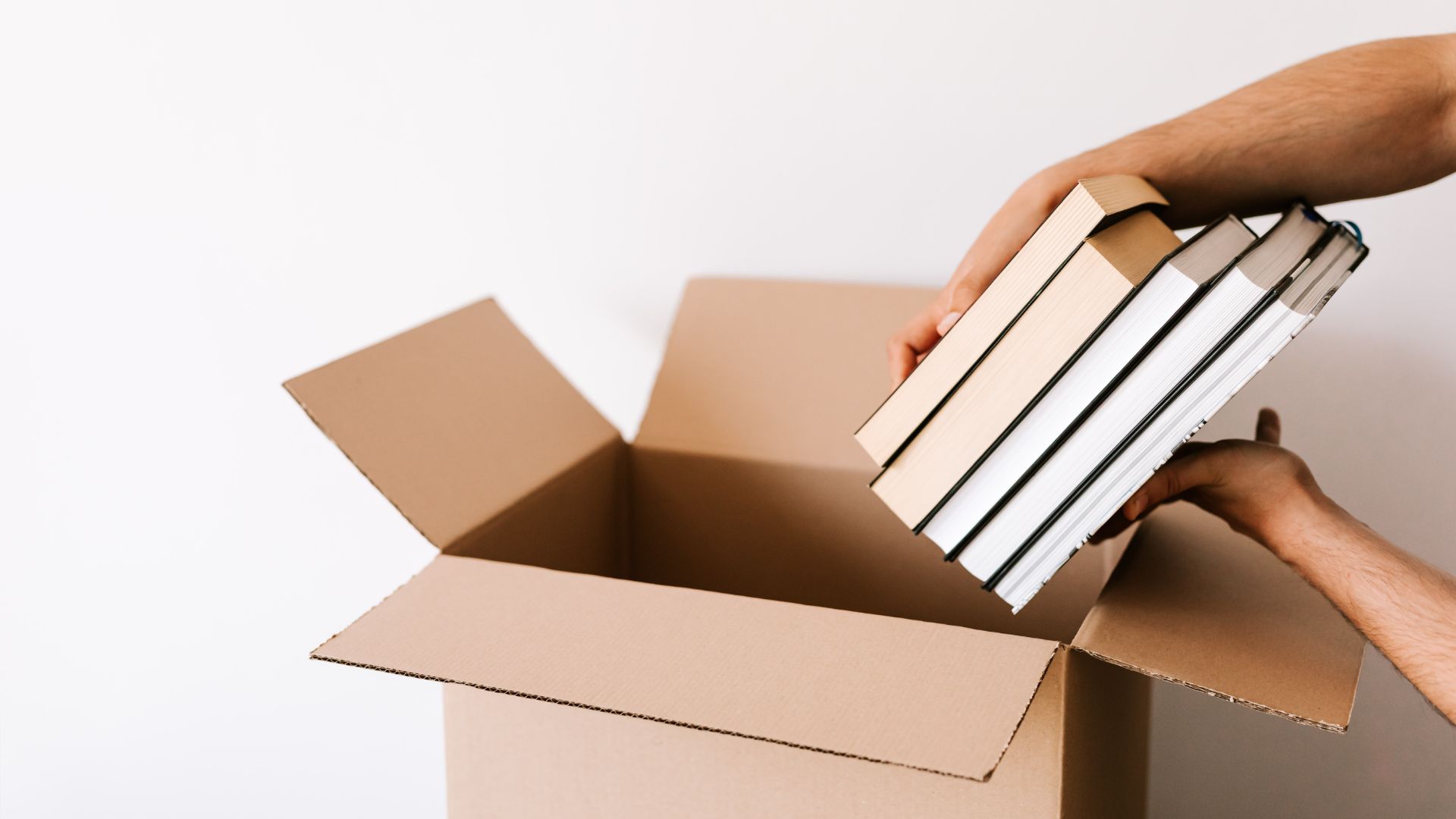
7. How to Package Books When Moving
Transporting books during a move can be a challenge due to their weight and fragility. However, with the right strategies, you can ensure their safe transportation.
- Sort by size and weight: Organize your books by their size and weight, and then pack them in a way that suits their characteristics. For heavy hardcover books, it is advisable to pack them in smaller boxes, as this will make them easier to handle and carry. On the other hand, paperbacks can be packed in slightly larger boxes that can accommodate their size.
- Use sturdy boxes: Opt for durable and robust boxes that are specifically designed to handle the weight of your treasured books, like specialized book boxes.
- Pack hardcovers upright: Arrange the hardcover books in the box, positioning them side by side as if they were neatly displayed on a bookshelf, ensuring that their spines are pressed against the side of the box.
- Stack paperbacks: Arrange your paperback books in a neat and flat stack to maintain the integrity of their covers and prevent any bending or damage to the pages.
- Use packing materials: For those precious and valuable books, it’s essential to give them the utmost care and protection during the move. Safeguard them by delicately wrapping each one in acid-free packing paper, ensuring that their pages and covers remain intact. To prevent any shifting or bending during transportation, make sure to fill any gaps in the box with reliable packing materials.
8. How to Pack Fragile Items for Move
Are you feeling uncertain about the best way to protect your delicate and fragile items during a move? No need to stress, I’m here to help you out!
Using the Right Packaging Materials
When it comes to properly packing fragile items, the first step is to gather the necessary supplies. It’s important to select the right materials based on the specific objects you are packing. For instance, packing a TV requires a different approach compared to packing delicate glassware.
To ensure the safety of your fragile items during the move, here are some essential packing supplies and materials that you should have on hand:
– Sturdy boxes: Opt for durable and strong boxes that are specifically designed to handle the weight and protect fragile items, such as specialized boxes for fragile belongings.
– Bubble wrap: Wrap your delicate items in bubble wrap to provide a cushioning effect and protect them from any potential damage during transportation.
– Packing paper: Use packing paper to wrap fragile items individually, ensuring that their surfaces are adequately covered and protected.
– Foam peanuts or packing peanuts: Fill any empty spaces in the boxes with foam peanuts or packing peanuts to prevent movement and provide additional cushioning for your fragile items.
– Packing tape: Securely seal the boxes with packing tape to ensure that they remain closed and protect the contents inside.
By using these essential packing supplies and materials, you can have peace of mind knowing that your fragile items will be well-protected and arrive safely at your new destination.
Put Glass and Ceramics in Small Boxes
Optimal protection for delicate items such as vases, plates, china cups, or glassware can be achieved by utilizing small boxes. Prior to placing each item in the box, individually wrap them with either packing paper or bubble wrap. By tightly filling each box, you minimize the amount of extra space available, thus reducing the risk of items shifting during transit.
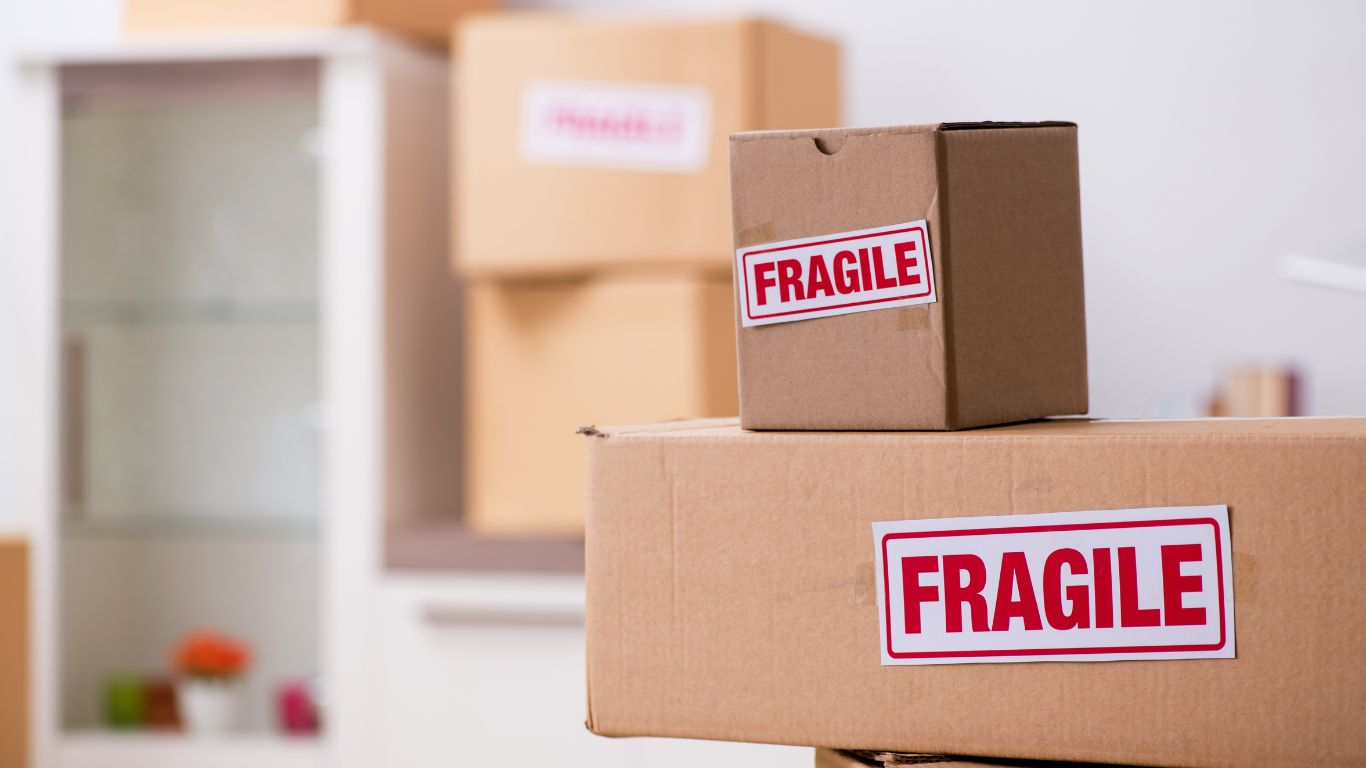
Label Fragile Boxes
Ensure that you clearly mark boxes containing delicate items as fragile to alert everyone handling them that extra care is required. Use a bold and noticeable marker to write “fragile” on all sides of the box. If you don’t have a black or red sharpie, consider purchasing one to make the label stand out even more. You can also use colored tape, such as red or pink, to draw attention to the breakable boxes. Taking these simple steps will help protect your fragile items during the move and ensure their safe arrival at your new home.
Place Heaviest Items at the Bottom of the Box
When it comes to packing, it’s important to remember the golden rule of grocery shopping: never put a carton of eggs underneath a bag of dog food. This principle also applies to packing your belongings for a move. As you begin to pack your boxes, make sure to prioritize placing heavier items at the bottom and lighter, more fragile items on top. This strategy not only ensures the safety of your belongings but also applies when loading your moving truck. So, remember to follow this philosophy and keep your items secure during the entire moving process.
Wrap and Fill Hollow Items With Packing Paper
To ensure the utmost protection for your fragile items, take extra care in wrapping them securely. Wrap delicate items in bubble wrap, tissue paper, or packing paper for added cushioning. For larger items like TVs and picture frames, consider using towels or blankets as an extra layer of protection. To prevent any mishaps during the move, use tape or bungee cords to secure the coverings tightly around these bulkier items. This way, you can have peace of mind knowing that your fragile belongings will arrive at your new destination intact and undamaged. Use packing paper to fill in any hollow items.
Use Cardboard Dividers
When it comes to packing fragile glassware, it’s essential to take extra precautions to ensure their safety. One effective method is to use cardboard dividers or specialized boxes designed to separate and protect each glass. By using these dividers, you can prevent any contact between the glasses, minimizing the risk of breakage due to pressure points or collisions.
To provide additional cushioning, start by securing the stems of wine glasses with bubble wrap, then wrap the entire glass in paper before wrapping it again with bubble wrap. This multi-layered approach will give your fragile glassware the utmost protection it deserves. Remember, when packing valuable, sentimental, or family heirloom glassware, it’s always better to err on the side of caution and take extra steps to ensure their safe transportation.
Loading a Moving Truck
Mastering the art of loading is crucial for a smooth and secure move. If you’re a DIY mover, here are some valuable tips to ensure a successful relocation.
- Start with heavy items: Begin by loading the heaviest items, such as furniture and appliances, first. This ensures that they are securely positioned at the front or along the sides of the moving truck, providing stability and minimizing the risk of shifting during transportation.
- Use tie-downs: Ensure the stability of your belongings during transportation by utilizing tie-downs to secure them to the walls of the moving truck. This precautionary measure will prevent any shifting or movement, guaranteeing a smooth and safe journey for your items.
- Pack boxes by weight: Arrange your boxes in a strategic manner, placing the heavier ones at the bottom and the lighter ones on top. This will not only ensure the stability of your belongings during transportation but also make it easier for you to unload and unpack them in your new home.
- Load items strategically: To optimize space and minimize the chances of damage, it’s essential to strategically position your items during the loading process. For instance, you can save valuable space by placing couches and mattresses on their sides. This clever technique not only maximizes the available space in the moving truck but also ensures the safety of your belongings throughout the journey.
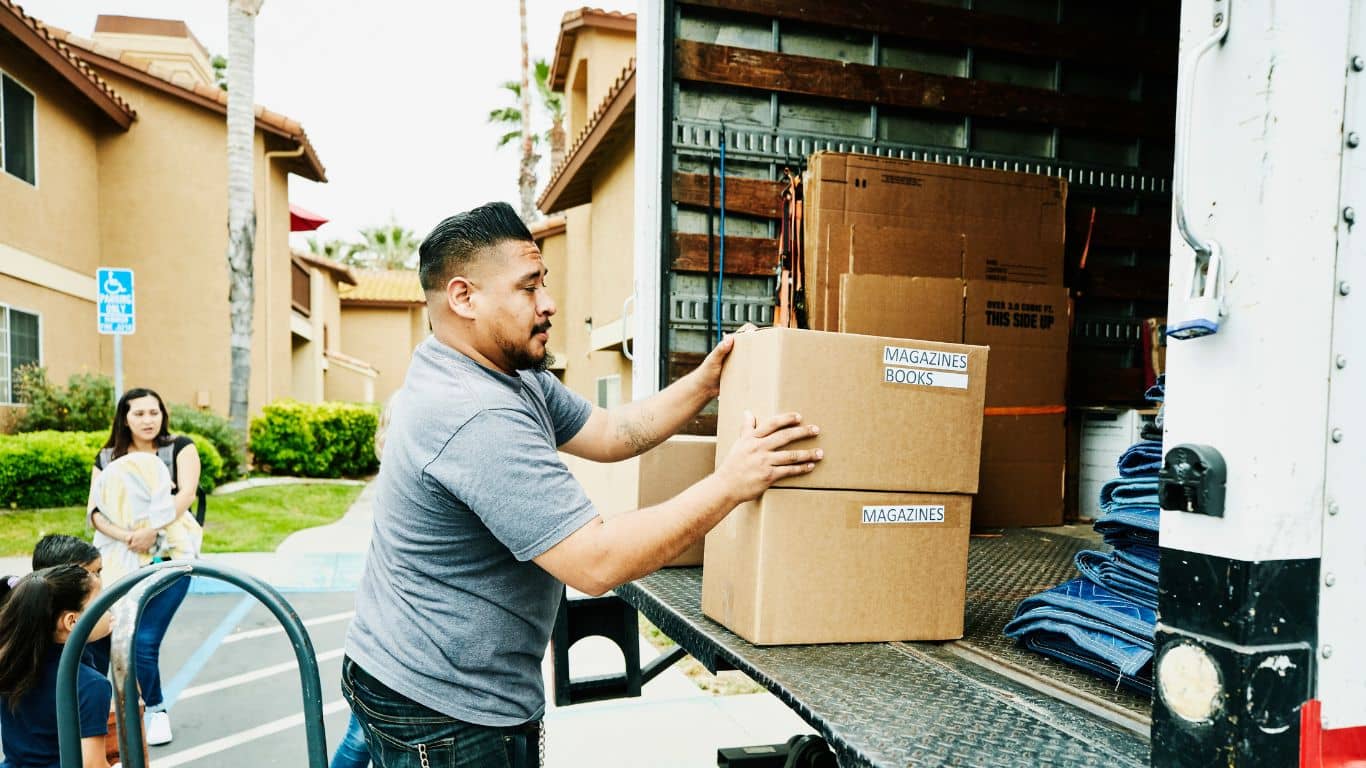
When enlisting the help of a professional moving company, it’s important to communicate with the movers about any fragile items that require special care during transport. Additionally, it’s a good idea to stay organized by keeping a detailed list of all the items being transported. This will help you keep track of your belongings and ensure that nothing gets left behind. As a gesture of appreciation, you may also consider offering refreshments to the movers throughout the day. This small act of kindness can go a long way in showing your gratitude for their hard work and dedication.
Unloading and Unpacking
Once you and your belongings arrive at your new home, it’s time to unload the truck and start unpacking. Here are some tips as you (or your interstate movers) unload and unpack:
- Unload items carefully: Handle the unloading process with care to prevent any damage to your belongings. Make use of a dolly or hand truck when moving heavy items, ensuring a smooth and safe transition from the truck to your new home.
- Check for damage: Examine each item for any signs of damage as you carefully unload them from the truck. It’s important to be vigilant and thorough during this process. Don’t forget to capture clear and detailed photos of any damages you come across. These photos will serve as valuable evidence for insurance claims if necessary.
- Unpack essentials first: Prioritize the unpacking of vital items like toiletries and a fresh set of clothes for a seamless transition into your new home.
- Follow your packing plan: Unpack each room systematically, following your meticulously crafted packing plan. Give priority to your sanctuary, bathroom, and kitchen, allowing yourself the luxury of a good night’s sleep, refreshing showers, and satisfying meals.
Conclusion:
Properly preparing for a move requires careful planning, organization, and attention to detail. By following these helpful tips and techniques, whether you choose professional assistance or take a DIY approach, you can rest assured that your household items will be packed securely and arrive safely at your new destination. Remember, investing time and effort into packing your belongings correctly will greatly reduce stress and the risk of damage during the moving process. Looking for trustworthy movers nearby to handle the job? Contact United Local Movers today!
